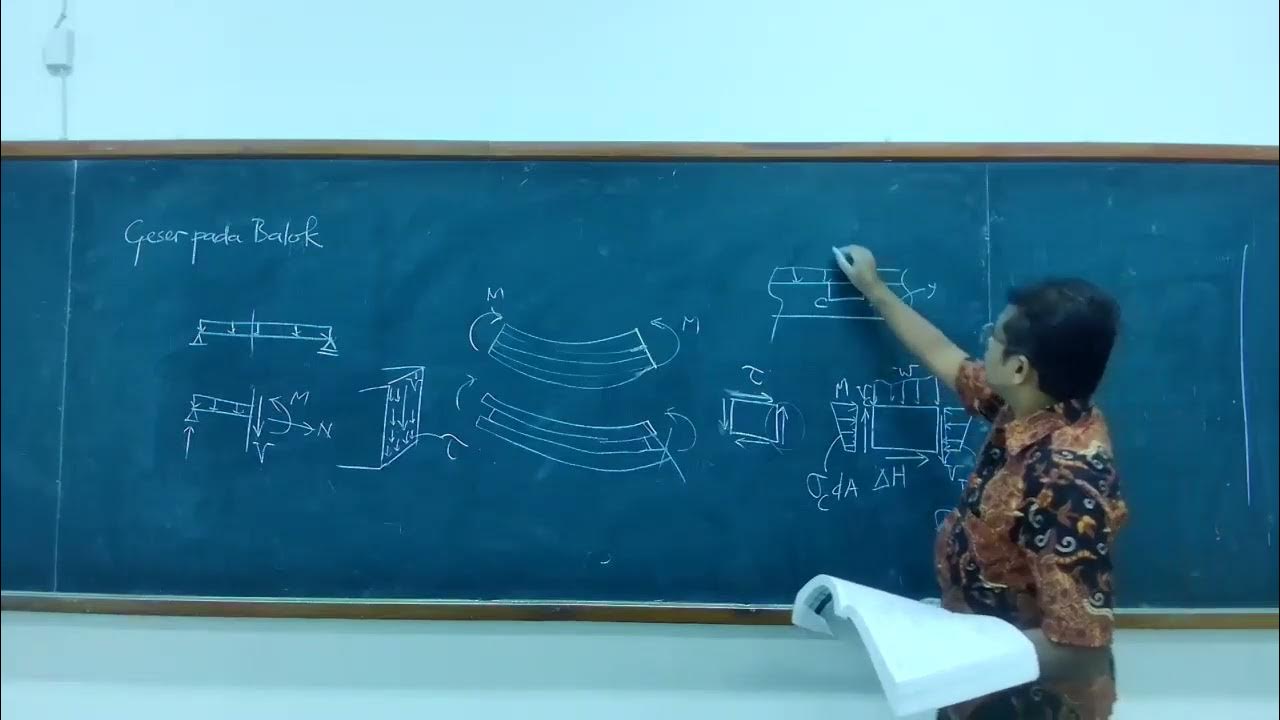Shear in Beams Model
Summary
TLDRThis educational video script explores the concept of shear stresses in beams, demonstrating how they arise from varying bending stresses along the beam's length. Using a cantilever beam example, it visually represents these stresses with arrows on Plexiglas blocks. The script explains the relationship between bending moments, shear forces, and the resultant shear flow patterns, illustrating the process with a step-by-step analysis of forces on individual fibers and the overall beam. It concludes with the mathematical formula linking shear to changes in bending moment, providing a comprehensive understanding of the topic.
Takeaways
- 📚 The model is designed to educate students on the origin of shear stresses in beams, their variation across a cross section, and the resulting shear flow patterns.
- 🏗️ The model is contextualized as part of a cantilever beam, with different bending moments at various sections, represented by red and blue arrows on Plexiglas blocks.
- 🔍 Arrow lengths are proportional to stress magnitude, and the volume of Plexiglas blocks is proportional to the force generated over their base area, indicating larger forces in flanges and smaller in the web.
- 📉 The difference in bending stresses along the beam's length is the reason shear stresses arise, with larger stresses at section B compared to A.
- ⚙️ Shear stresses are visualized by imagining a cut through a beam fiber, requiring an equal and opposite force for equilibrium, represented by arrows with a single-sided head.
- 🔄 The maximum shear force is found at the neutral axis because fibers below this axis carry compression, leading to an opposite axial imbalance.
- 📊 Shear stress distribution is linear and can be plotted as a function of distance from the flange's outer extremity, confirmed by calculations.
- 🌐 Shear flow is understood by transferring shear stresses from longitudinal cutting planes to the beam cross section, showing how forces must act for equilibrium.
- 📐 The shear stress in the web takes a parabolic form, which can be represented graphically to understand its distribution across the cross section.
- 🔗 Shear and changes in bending moment are closely related, mathematically explained by the formula V=dM/dx, where V is the shear force and M is the bending moment.
- 👀 The video aims to clarify the concepts of shear stresses, their variation over a beam's cross section, and the formation of shear flow patterns for better understanding.
Q & A
What is the primary purpose of the model discussed in the video?
-The model is designed to help students understand how shear stresses arise in beams, why they vary across a beam's cross section, and how they produce specific shear flow patterns.
What is a cantilever beam and how does it relate to the model?
-A cantilever beam is a structural element that is fixed at one end and free at the other, allowing it to extend horizontally. The model is part of a cantilever beam, illustrating how bending moments and shear stresses vary along its length.
How are bending stresses represented in the model?
-Bending stresses are represented using arrows overlaid on Plexiglas blocks. Tensile stresses are shown with red arrows, while compressive stresses are shown with blue arrows.
Why do shear stresses arise in a beam?
-Shear stresses arise in a beam due to differences in bending stresses from one section to another along the length of the beam.
What is the significance of the length of the arrows in the model?
-The length of each arrow is proportional to the magnitude of the stress it represents, allowing the volume of each Plexiglas block to be proportional to the force generated over its base area.
How does the position of forces on the beam affect the bending moment?
-Forces that are relatively far from the neutral axis of the beam contribute more to the bending moment due to their longer moment arms compared to forces that act at a shorter moment arm.
What is a free body in the context of the video?
-A free body is a conceptual tool used to analyze the forces acting on a specific part of the beam, such as a fiber, by considering it isolated from the rest of the structure.
How are shear forces represented in the model?
-Shear forces are represented using arrows with a single-sided head, indicating that they act parallel to the cut and are a result of the axial imbalance of the fibers.
Why is the maximum shear force found at the neutral axis of the beam?
-The maximum shear force is found at the neutral axis because fibers below the neutral axis carry compression, which reduces the total axial imbalance compared to a beam cut right at the neutral axis.
What is the relationship between shear stress and the distance from the outer extremity of the flange?
-The magnitude of the shear stress can be plotted as a function of the distance from the outer extremity of the flange, showing a linear relationship as confirmed by the calculations.
What is shear flow and how is it represented in the model?
-Shear flow refers to the distribution of shear forces over the cross section of a beam. It is represented in the model by arrows on the cross section that indicate the direction and magnitude of the shear forces acting on the beam.
How can the shear forces on a beam be determined from the bending stresses?
-Shear forces on a beam can be determined from the bending stresses by analyzing the differences in stresses on nearby cross sections and using the rate of change of bending moment with axial position, as described by the formula V=dM/dx.
Outlines

此内容仅限付费用户访问。 请升级后访问。
立即升级Mindmap

此内容仅限付费用户访问。 请升级后访问。
立即升级Keywords

此内容仅限付费用户访问。 请升级后访问。
立即升级Highlights

此内容仅限付费用户访问。 请升级后访问。
立即升级Transcripts

此内容仅限付费用户访问。 请升级后访问。
立即升级5.0 / 5 (0 votes)






